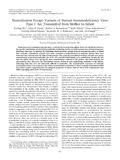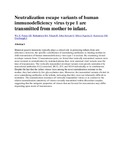| dc.contributor.author | Wu, X | |
| dc.contributor.author | Parast, AB | |
| dc.contributor.author | Richardson, BA | |
| dc.contributor.author | Nduati, RW | |
| dc.contributor.author | John-Stewart, G | |
| dc.contributor.author | Mbori-Ngacha, DA | |
| dc.contributor.author | Rainwater, SM | |
| dc.contributor.author | Overbaugh, J | |
| dc.date.accessioned | 2013-06-10T09:55:13Z | |
| dc.date.available | 2013-06-10T09:55:13Z | |
| dc.date.issued | 2006-01 | |
| dc.identifier.citation | J Virol. 2006 Jan;80(2):835-44. | en |
| dc.identifier.uri | http://www.ncbi.nlm.nih.gov/pubmed/16378985 | |
| dc.identifier.uri | http://erepository.uonbi.ac.ke:8080/xmlui/handle/123456789/30631 | |
| dc.description.abstract | Maternal passive immunity typically plays a critical role in protecting infants from new infections; however, the specific contribution of neutralizing antibodies in limiting mother-to-child transmission of human immunodeficiency virus type 1 is unclear. By examining cloned envelope variants from 12 transmission pairs, we found that vertically transmitted variants were more resistant to neutralization by maternal plasma than were maternal viral variants near the time of transmission. The vertically transmitted envelope variants were poorly neutralized by monoclonal antibodies b12 [corrected] 2G12, 2F5, and 4E10 individually or in combination. Despite the fact that the infant viruses were among the most neutralization resistant in the mother, they had relatively few glycosylation sites. Moreover, the transmitted variants elicited de novo neutralizing antibodies in the infants, indicating that they were not inherently difficult to neutralize. The neutralization resistance of vertically transmitted viruses is in contrast to the relative neutralization sensitivity of viruses sexually transmitted within discordant couples, suggesting that the antigenic properties of viruses that are favored for transmission may differ depending upon mode of transmission. | en |
| dc.language.iso | en | en |
| dc.publisher | University of Nairobi. | en |
| dc.title | Neutralization escape variants of human immunodeficiency virus type 1 are transmitted from mother to infant | en |
| dc.type | Article | en |
| local.publisher | Division of Human Biology, Fred Hutchinson Cancer Research Center, USA | en |
| local.publisher | Department of Paediatrics and Child Health, Univeristy of Nairobi, Kenya | en |


